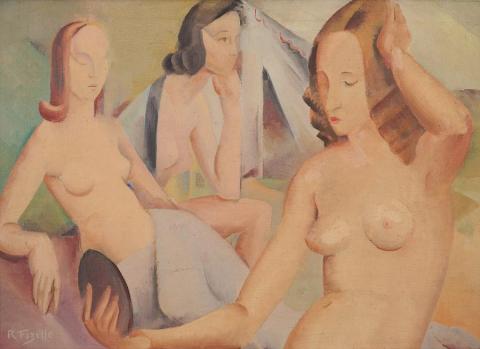THREE NUDES, c.1938
RAH FIZELLE
oil on canvas on board
32.0 x 44.5 cm
signed lower right: R. Fizelle
Joseph Brown Gallery, Melbourne
Private collection, Melbourne, acquired from the above in November 1976
Spring exhibition 1976, Joseph Brown Gallery, Melbourne, 18-29 October 1976, cat. 40
Balson - Fizelle - Hinder: An Exhibition of Abstract Art in Sydney 1930 to 1960, Sotheby's Gallery, Sydney, 1998 (illus. in exhibition catalogue)
Modern Australian Painting, Charles Nodrum Gallery, Melbourne, 12 April - 5 May 2012, cat. 15 (illus. in exhibition catalogue)
Chambers, N., 'The Mathematisation of Nature in the Work of Balson, Fizelle and Hinder', in Balson - Fizelle - Hinder: An Exhibition of Abstract Art in Sydney 1930 to 1960, Sotheby's Gallery, Sydney, 1998
'We were united in one belief, the constructive approach to painting, and this insistence on the abstract elements in building a design was the keynote of our teaching with both Lhote and Gleizes.1
The following excerpt is from Harding L., 'Rah Fizelle's images of the city and Sydney mural painting', in Edward, D. (ed.), Sydney Moderns: Art for a New World, Art Gallery of New South Wales, Sydney, 2013, p. 170:
'[Dorrit] Black's Modern Art Centre (1931-1933) played a brief but important role in introducing European modernism and most notably, cubist methods, to Sydney, the spirit of which continued when Fizelle and Crowley opened their own school at 215a George Street. The curriculum was initially based on Crowley's experiences at the Académie Lhote in Paris, which taught a modified version of cubism popular with English-speaking students.
'Fizelle, with a natural inclination towards theory, embraced André Lhote's methods and took up the teaching of dynamic symmetry at the George Street studio, despite gleaning its principles in a second-hand fashion via Crowley and later Frank Hinder and from books they suggested. Lhote's appreciation for the compositional logic of works from the history of western painting, especially classical and Renaissance art, seems to have aligned neatly with Fizelle's own proclivities.'
1. Grace Crowley papers, Art Gallery of New South Wales Research Library and Archive, Sydney
